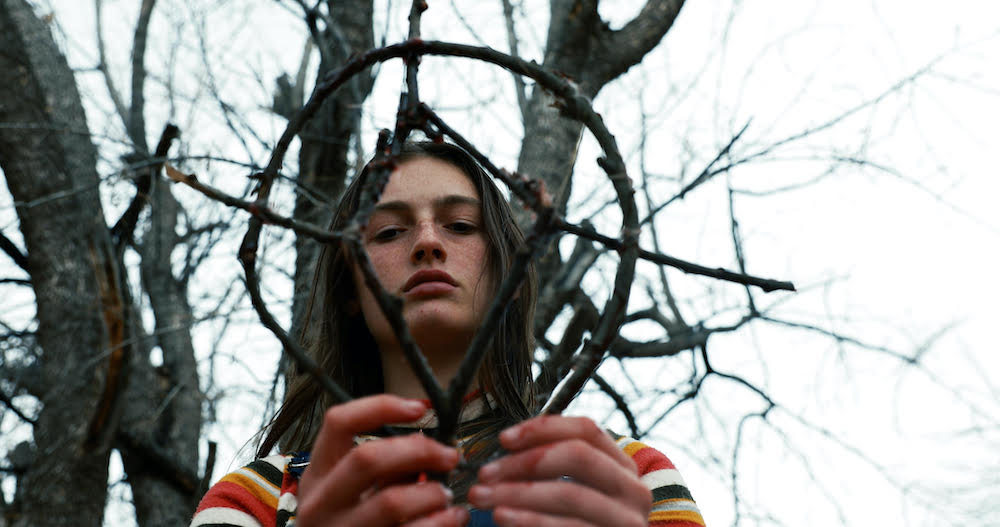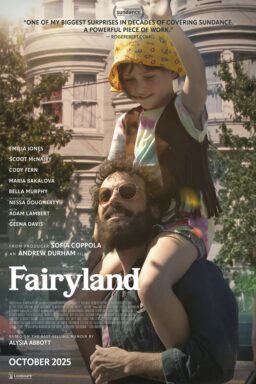One of the most striking world premieres I’ve seen during my four years of Fantasia was “The Deeper You Dig,” by a filmmaking family comprised of Toby Poser, John Adams, and Zelda Adams—a mother, father, and daughter. The movie did not work for me as much as I wanted to, and I was thrilled that Glenn Kenny saw more in it than I did, but it left a lasting impression. That film has since become a word-of-mouth hit on Shudder, at least among my fellow horror fans, and it’s not just because the filmmakers have such a unique relationship with each other.
The Adams family returns this year with “Hellbender,” an incredibly vivid product of an authorship that is distinct and continuously promising (the three are all credited as writers and directors). They are so harmonious with nature, crafty low-budget filmmaking, and themselves, and those components all pop in this micro-budget story of a mother whose daughter has monstrous tendencies that the young woman is unaware of. The two women live on some mountain in New York, where the mother collects pine cones and twigs for food. She also can lift people in the air and make them disappear, as we see in an early sequence featuring John Adams. That moment occurs among a whole assortment of other low-key, witchy acts.
“Hellbender” echoes the immense, fascinating power of its filmmakers, by showing two of them in another form—as musicians, with Zelda rocking the drums and Posner on the bass. The high-energy songs bleed into the rest of the story, which is about their way of life, and Zelda’s Izzy realizing why she’s not like other people her age. Her mother told her that she was sick, that she had to stay away from people and much of the world, but in the script’s progressive plotting, one atmospheric but off-beat scene to the next, she realizes this power, and how it feeds on fear. When she eats an earthworm, it’s causes something of an acid trip. “Hellbender” gets even nuttier when Izzy develops a hunger for more, bringing to light the codependency she has with her mother, and the family’s legacy.
There are many fascinating elements about this movie that slowly wrap themselves around you: the monotone but gripping performances from Poser and Adams as they share trippy mother/daughter moments; the tornado-like acid trips that spike disorienting camerawork with freaky gory images; the special effects and in-camera work that casually creates magic (like a key that through a hand after one places their hand on a wall). Much of it comes in potent doses, from a story that is incredibly assured of when to ramp things up, or when to sit. Part of the thrill of “Hellbender” is basking in that assurance, and to then be shocked, impressed, or moved by a family that has great horror filmmaking in their blood.

“The Righteous,” another world premiere from the festival, is likely the fest’s most Bergman-y movie this year, given how its black-and-white cinematography and utterances about fearing God echo shots in “The Virgin Spring” and “Winter Light.” Those are incredible films of course, and it becomes exciting to see a movie—regardless of the festival it’s playing in—amp up their DNA for psychological horror, albeit unfolding mostly through conversations at a dinner table.
Henry Czerny gives a rich, tormented performance in the movie as Frederic, a man with a complicated past. He used to be a priest, for one, but left that path and married later in life. “The Righteous” catches him right after a tragedy, in which his daughter—who we learn shortly was adopted—was killed in a shattering incident. He prays on it, and sits in his countryside home with his wife Ethel (Mimi Kuzyk) that he loves. Their scenes together, brief moments of peace in a movie that finds chaos in silence, are warming, and totally endearing.
A man named Aaron suddenly appears in their yard, with a bad leg. He’s in pain, he needs help. Where he came from, what he was doing, who he really is, all of it becomes a question. With writer/director Mark O’Brien playing into the unease of an uninvited guest, the man is able to convince the couple to let him stay the night. He becomes bad with boundaries, he contradicts himself. There’s too little plot to these moments, but the pushiness becomes its own feeling. As Aaron sits with Frederic, going from houseguest to forceful therapist, he starts to pull and push at darker parts of Frederic, and then offers him a type of twisted salvation.
Writer/director Mark O’Brien casts himself as Aaron, an emphasis of the movie’s startling “where the hell did you come from?” energy. In this debut, his emotional control becomes apparent, in patiently building suspense through dialogue and calm performances in which single tears drop from their faces while they bare their souls. If the script is a little too narrow with its ideas, or on-the-nose with some dialogue that breaks the storytelling’s spell, it at least displays an ambitious leader of performances and someone with ideas that continue the conversations from Bergman’s best. It’s a more tactful Bergman homage than Paul Schrader’s unabashed rip-off “First Reformed,” and it should play well with the same type of viewers who enjoy pondering the all-encompassing, terrifying power of God.

A different story of faith and punishment can be found in the period piece “The Last Thing Mary Saw,” which is due to arrive to Shudder next year. Written and directed by Edoardo Vitaletti, the movie captures many things that we’ve more or less seen before in horror movies, without having any grandiose statements to it. Its grim tale of a woman (Isabelle Fuhrman) who has a relationship with her family’s housemaid Mary (Stefanie Scott)—causing the fervently religious townsfolk to punish them, leading to a type of comeuppance—is much more straightforward than it is remotely surprising or stunning. Even with this relationship at the center, the movie’s emotions and its ideas are predominantly hollow.
“The Last Thing Mary Saw” is the case of many elements—performances, costume design, candlelit cinematography—trying to help a writer/director earn their grave self-seriousness. It rarely all comes together. The script does not have enough ambition to warrant the cold nature and sluggish pacing, and its general ideas about the scandal at the center are nil. It’s telling too that the horror elements, which involves ominous old ladies and blood-spewing death, don’t add to major scare but more obvious story details.
The movie gets its title from its bookending scenes, related to a bloody Mary in a blindfold, being asked by disturbed men about what happened. This narrative device almost proves counterintuitive, taking away from the tension in watching things go from silent to violent and a little ghostly, aware that they’ll reach a certain endpoint. But it’s also one of the few hooks this story has, even when Rory Culkin suddenly shows up in act two with a facial deformity.












